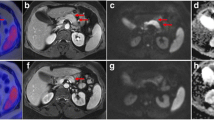Abstract
Purpose
The aim of this study was to evaluate retrospectively the efficacy of whole-body 18F-fluorodeoxyglucose positron emission tomography (FDG-PET) for autoimmune pancreatitis (AIP) and associated extrapancreatic autoimmune lesions.
Methods
Whole-body FDG-PET or PET/computed tomography (CT) findings were reviewed in six patients with AIP. The initial PET scans were performed 1 h and 2 h after FDG injection in all six patients. Follow-up PET scans were performed during or following steroid therapy in five patients and in one patient who did not have steroid therapy.
Results
The initial PET scans revealed intense FDG uptake by AIP in all six patients. The maximum standardized uptake value (SUVmax) increased in four patients and was stable in two patients. The intense uptake in the pancreas disappeared during or following steroid therapy in five patients and in one patient who showed spontaneous remission of AIP. Abnormal FDG uptake by extrapancreatic autoimmune diseases was observed in five of the six patients: sclerosing sialadenitis (n = 5), lymphadenopathy (n = 5), retroperitoneal fibrosis (n = 2), interstitial nephritis (n = 2) and sclerosing cholecystitis (n = 1). Abnormal FDG uptake disappeared in the salivary glands (n = 4), lymph nodes (n = 4), retroperitoneum (n = 2), kidneys (n = 1) and gallbladder (n = 1) during or following steroid therapy and remained in the salivary glands and lymph nodes of a spontaneous remission patient.
Conclusion
These results suggest that whole-body FDG-PET may be useful for detecting AIP and associated extrapancreatic autoimmune lesions and for monitoring their disease activity but that dual time point imaging may not be useful for differentiating malignancy from AIP.



Similar content being viewed by others
References
Rigo P, Paulus P, Kaschten BJ, Hustinx R, Bury T, Jerusalem G, et al. Oncological applications of positron emission tomography with fluorine-18 fluorodeoxyglucose. Eur J Nucl Med 1996;23:1641–74.
Pauwels EKJ, Ribeiro MJ, Stoot JHMB, McCready VR, Bourguignon M, Maziere B. FDG accumulation and tumor biology. Nucl Med Biol 1998;25:317–22.
Sugawara Y, Braun DK, Kison PV, Russo JE, Zasadny KR, Wahl RL. Rapid detection of human infections with fluorine-18 fluorodeoxyglucose and positron emission tomography: preliminary results. Eur J Nucl Med 1998;25:1238–43.
Yoshida K, Toki F, Takeuchi T, Watanabe S, Shiratori K, Hayashi N. Chronic pancreatitis caused by an autoimmune abnormality. Proposal of the concept of autoimmune pancreatitis. Dig Dis Sci 1995;40:1561–8.
Kamisawa T, Okamoto A. Autoimmune pancreatitis: proposal of IgG4-related sclerosing disease. J Gastroenterol 2006;41:613–25.
Kamisawa T, Egawa N, Nakajima H, Tsuruta K, Okamoto A. Extrapancreatic lesions in autoimmune pancreatitis. J Clin Gastroenterol 2005;39:904–7.
Members of the Criteria Committee for Autoimmune Pancreatitis of the Japan Pancreas Society. Diagnostic criteria for autoimmune pancreatitis by the Japan Pancreas Society (2002). J Jpn Panc Soc 2002;17:585–7.
Nakajo M, Jinnouchi S, Noguchi M, Uozumi K, Tanabe H, Tateno R, et al. FDG PET and PET/CT monitoring of autoimmune pancreatitis associated with extrapancreatic autoimmune disease. Clin Nucl Med 2007;32:282–5.
Defrise M, Kinahan PE, Townsend DW, Michel C, Sibomana M, Newport DF. Exact and approximate rebinning algorithms for 3D PET data. IEEE Trans Med Imaging 1997;16:145–58.
Salvarani C, Pipitone N, Versari A, Vaglio A, Serafini D, Bajocchi G, et al. Positron emission tomography (PET): evaluation of chronic periaortitis. Arthritis Rheum 2005;53:298–303.
Koyama K, Okamura T, Kawabe J, Nakata B, Chung KH, Ochi H, et al. Diagnostic usefulness of FDG PET for pancreatic mass lesions. Ann Nucl Med 2001;15:217–24.
Okazaki K, Chiba T. Autoimmune related pancreatitis. Gut 2002;51:1–4.
Kamisawa T, Egawa N, Nakajima H, Tsuruta K, Okamoto A. Morphological changes after steroid therapy in autoimmune pancreatitis. Scand J Gastroenterol 2004;39:1154–8.
Deshpande V, Mino-Kenudson M, Brugge W, Lauwers GY. Autoimmune pancreatitis: more than just a pancreatic disease? A contemporary review of its pathology. Arch Pathol Lab Med 2005;129:1148–54.
Nakamoto Y, Saga T, Ishimori T, Higashi T, Mamede M, Okazaki K, et al. FDG-PET of autoimmune-related pancreatitis: preliminary results. Eur J Nucl Med 2000;27:1835–8.
Tanabe T, Tsushima K, Yasuo M, Urushihata K, Hanaoka M, Koizumi T, et al. IgG4-associated multifocal systemic fibrosis complicating sclerosing sialadenitis, hypophysitis, and retroperitoneal fibrosis, but lacking pancreatic involvement. Intern Med 2006;45:1243–7.
Ozden I, Dizdaroglu F, Poyanli A, Emre A. Spontaneous regression of a pancreatic head mass and biliary obstruction due to autoimmune pancreatitis. Pancreatology 2005;5:300–3.
Okazaki K. Autoimmune pancreatitis: etiology, pathogenesis, clinical findings and treatment. The Japanese experience. JOP 2005;6:89–96.
Hamano H, Kawa S, Horiuchi A, Unno H, Furuya N, Akamatsu T, et al. High serum IgG4 concentrations in patients with sclerosing pancreatitis. N Eng J Med 2001;344:732–8.
Zhuang H, Pourdehnad M, Lambright ES, Yamamoto AJ, Lanuti M, Li P, et al. Dual time point 18F-FDG PET imaging for differentiating malignant from inflammatory processes. J Nucl Med 2001;42:1412–7.
Ishimori T, Saga T, Mamede M, Kobayashi H, Higashi T, Nakamoto Y, et al. Increased 18F-FDG uptake in a model of inflammation: Concanavalin A-mediated lymphocyte activation. J Nucl Med 2002;43:658–63.
Boellaard R, Krak NC, Hoekstra OS, Lammertsma AA. Effects of noise, image resolution, and ROI definition on the accuracy of standard uptake values: a simulation study. J Nucl Med 2004;45:1519–27.
Westerterp M, Pruim J, Oyen W, Hoekstra O, Paans A, Visser E, et al. Quantification of FDG PET studies using standardised uptake values in multi-centre trials: effects of image reconstruction, resolution and ROI definition parameters. Eur J Nucl Med Mol Imaging 2007;34:392–404.
Acknowledgements
The authors thank Dr. Hideaki Uozumi (Uozumi Clinic) for providing us the follow-up data of Patient 2.
Author information
Authors and Affiliations
Corresponding author
Rights and permissions
About this article
Cite this article
Nakajo, M., Jinnouchi, S., Fukukura, Y. et al. The efficacy of whole-body FDG-PET or PET/CT for autoimmune pancreatitis and associated extrapancreatic autoimmune lesions. Eur J Nucl Med Mol Imaging 34, 2088–2095 (2007). https://doi.org/10.1007/s00259-007-0562-7
Received:
Accepted:
Published:
Issue Date:
DOI: https://doi.org/10.1007/s00259-007-0562-7




